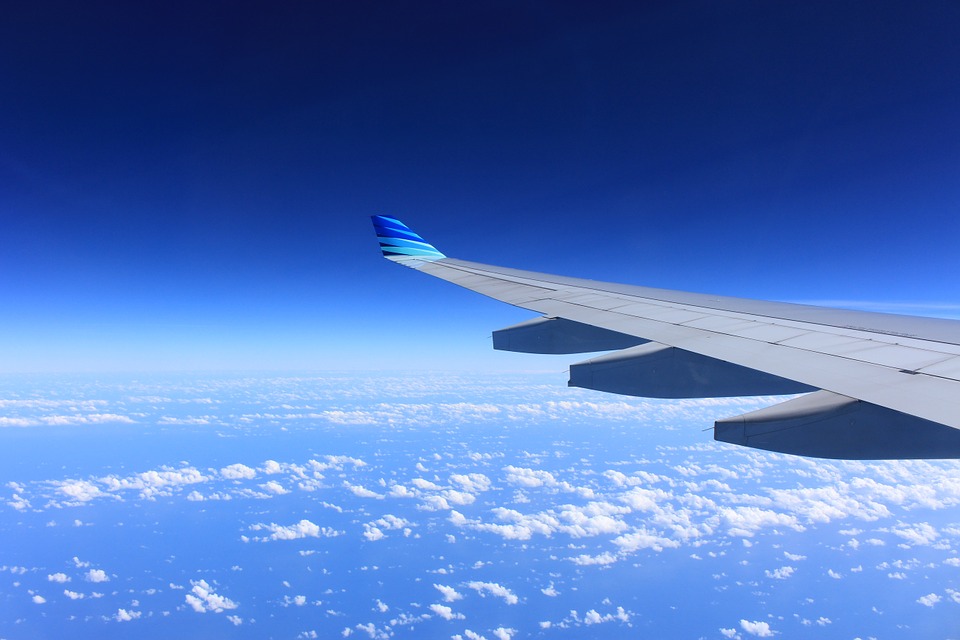The Real Cost of Air Travel Is Much Lower Than You Think

Airline tickets are not nearly as expensive as they used to be in the Golden Age of travel, but they can still be quite pricey at times. You might be surprised to learn, however, that your actual airfare – that is the amount of money charged by the airline for your seat on the plane – is quite reasonable. In fact, many international airline tickets can even be quite cheap.
It’s actually government fees and taxes that jack up the cost of air travel today, not the airlines. Sometimes the cost of these arbitrary additions can even be greater than the airfare itself. But national governments do not want you to see how much they are tacking on to your trip for themselves, so they force the airlines to hide these exorbitant taxes and tell you that the total is all just the cost of your transport.
To help illuminate the real cost of an international airline ticket and tease out how little the airline actually needs and wants to charge you for that trip, I analyzed the fare breakdowns of five popular international routes from North America earlier this year to see how much of those published fares were actual airfare versus government-imposed – and government hidden – taxes and fees.
New York City to London
The first fare I priced out was from New York’s John F. Kennedy International Airport (JFK) to London’s Heathrow International Airport (LHR). A round-trip ticket leaving on January 8, 2018 and returning a week later on January 15th priced out at a mere $560.56 for a basic economy round-trip ticket on Delta AirLines. (regular economy was only $30 more). Not bad. Of that fare, only $347 would go to Delta, while the remaining $213.56 goes to the American and British governments as mandatory taxes and fees.
The United States takes $62.56 of that in the form of five different federal taxes and fees, including an airport user fee of $4.50 that goes to JFK. The United Kingdom, on the other hand, takes the remaining $151 as a tax on you for coming to see Big Ben, including an astounding airport service charge of $53.80 for using Heathrow airport.
All of this means that the real cost to fly round-trip from New York to London on these dates is only $347, and that includes the small internal profit for the airline. The remaining 38% of the ticket price is an add-on by the two governments, who then force the airlines to hide their haul in with the actual fare and call the price you see and get charged a “total fare.” But what this policy is really hiding is the fact that you were just hit with a 61.5% tax on your $347 purchase.
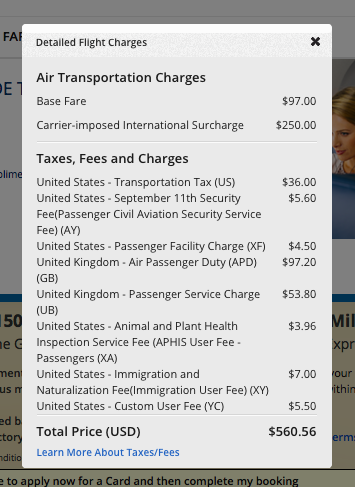
Chicago to Paris
For a trip from Chicago to Paris on the same dates in January of 2018, a round-trip economy ticket on United Airlines priced out at $696.16. Of that fare, $573 was the amount of the actual airfare and $123.16, or 17.6%, would go to government taxes and fees. The United States would take $62.56 of that, including a $4.50 airport charge for flying out of Chicago’s O’Hare International Airport (ORD), and France would get $43.90, including a $13.80 airport charge for using Charles de Gaulle International Airport (CDG). Switzerland also takes a cut of $16.70 from your “total fare” on this itinerary too, since the return flight has a layover in Zurich. In all, this fare is being taxed at an effective rate of 21.5%.
While most government-imposed fees on airline travel go to fund travel-related government services such as security, immigration, customs, and airport operations, travelers to France may notice another peculiar tax added into their total fare called the France Air Passenger Solidarity Tax. The $5.40 per passenger collected via this tax by the French government goes to finance French foreign aid to developing countries.
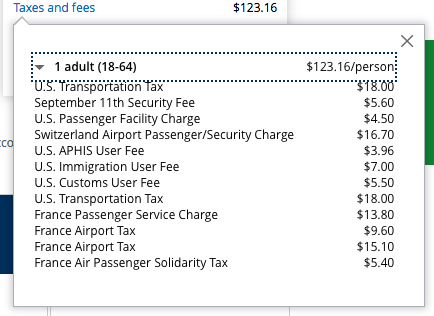
Los Angeles to Tokyo
The next trip I priced out for comparison was a trans-Pacific route from Los Angeles International Airport (LAX) to Tokyo’s Narita International Airport (NRT) using the same dates, which came to a total of $776.26 for a round-trip economy ticket on American Airlines. Of that total, $690 will go to the airline itself and the other $86.26, or about 11% of the total fare, will go to the governments of the United States and Japan for taxes and fees.
While Japan does not charge any taxes on visitors’ airfares, it does add on $4.70 as a security fee and a $19 fee to fly into and out of Narita airport in Tokyo (the fee for Tokyo’s other airport, Haneda, would have been $23.40). The balances of this ticket’s tax and fee charges go to the United States, of which only $4.50 goes to the facility charge for LAX. In total, you would be paying a 12.5% tax on the real cost of this ticket.
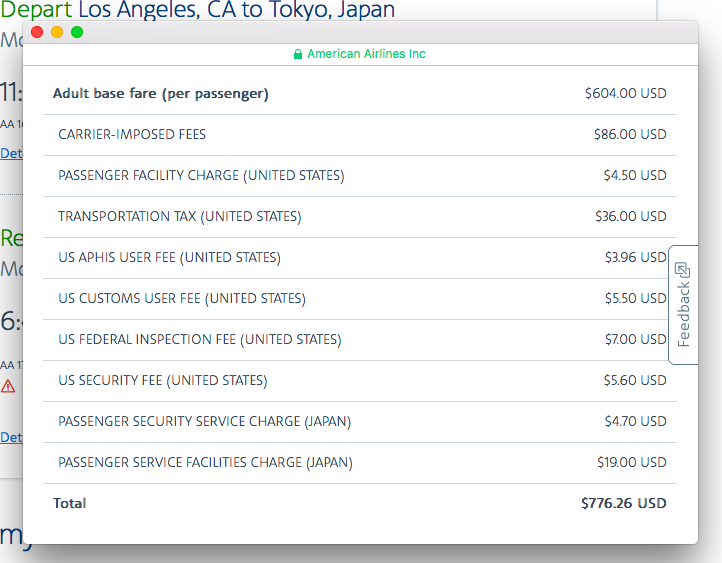
Orlando to Mexico City
Finally, I checked out fares from Orlando (MCO) to Mexico City (MEX), again using the exact same dates and performing all searches within the same hour in order to help control for seat inventory and fare class fluctuations over time. The roundtrip economy fare offered by JetBlue on this route, which they call a “Blue” fare, came to $292.58, of which $157 would go to JetBlue and $135.58 would go to the American and Mexican governments in taxes and fees.
Mexico charges visitors both a departure tax and a tourism tax, meaning out of this fare $73.02 would have to be remitted to the Mexican government in taxes. The remaining $62.56 would go to the US government to cover its various taxes and fees. This means that over 46% of the total fare that JetBlue has to quote you for this flight is actually hidden taxes and fees imposed by the governments of the United States and Mexico. In other words, there is an eye-popping 86% government charge added onto the simple $157 airfare for this flight.
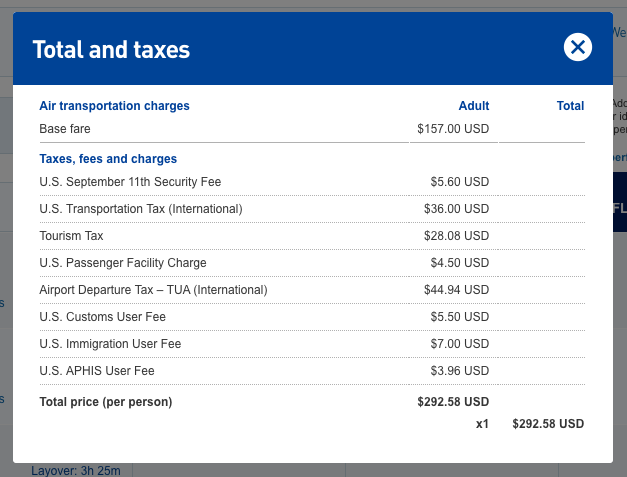
While it is understandable that governments have to pay for services provided to travelers, most would agree that an effective tax rate of 60%, 80%, and sometimes even 100% on airfare purchases is simply outrageous. This also reveals why governments are insistent on forcing airlines to conceal the government-imposed taxes on airfare behind a “total fare” scheme in which the true fare breakdown is only visible after clicking on a small-print link buried in the fare details.
So what does this mean for consumers who still want to get out there and explore the world while spending smartly? Well for starters it means that you should consider comparison shopping not only airlines and dates, but also your arrival and departure countries. For example, when I travel to Europe, I always avoid returning from any UK airport because of that government’s sky-high departure taxes that get added onto any departing ticket (in-transit departures excluded).
Another example available to those in Southern California is the ease and convenience of using the Cross Border Xpress Bridge to Tijuana’s border-adjacent airport, which allows passengers to save not only on the US departure and arrival taxes but also Mexican tourism taxes.
Until governments decide to be more transparent about the true cost of air travel, or better yet until they start lowering or repealing some of these pricey add-ons, be sure to take advantage of that fine print link that says “taxes and fees.” Your eyes might pop out of your head, but your wallet will appreciate your due diligence.


